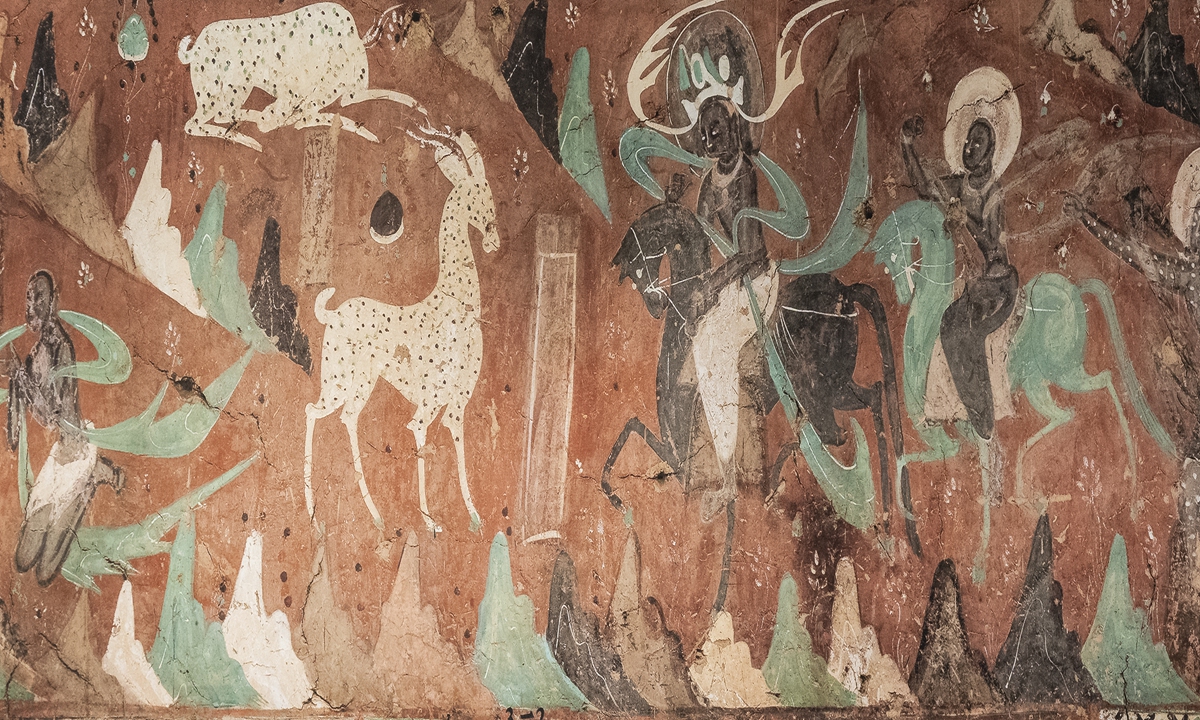
Murals inside Mogao Caves in Dunhuang, Northwest China's Gansu Province Photo: VCG
Dunhuang in Northwest China's Gansu Province hosts thousands of tourists in the summer, but during the slack season, the number of visitors could drop sharply due to the freezing wind of the Gobi Desert.
Harboring the UNESCO World Heritage site of the Mogao Caves, as well as tourist sites such as the famed Crescent Spring, Dunhuang, a border town during Han Dynasty (206BC-AD220), has witnessed ancient China's communication with other civilizations along the Silk Road.
The Dunhuang Academy, the research institute that oversees the preservation of the Mogao Caves, has put a limit on the number of daily visitors to the site at 6,000 to protect it from further damage, as the fragile site risks damage even from people's breath.
The slow season, a tranquil interlude, casts its enchantment over the land, transforming Dunhuang into a sanctuary of whispered tales waiting to be discovered.
Smaller groupsA mere number of 1,500 daily visitors during the off-season means being able to enjoy the cavernous silence within the grottoes, which offer a canvas for contemplation rather than a space to tolerate the hassle and bustle of the summer queues.
Tourists are usually divided in groups of 25 people each and then guided by a knowledgeable custodian to visit the predesignated eight caves, after purchasing a 238 yuan ($33) ticket.
But with the slow season, other possibilities emerge. Lately, the local government has introduced new policies to attract more tourists for the slow season.
Now every visitor can explore 12 caves in one single entry to the Mogao Caves site, enjoying a lower entry fee to 140 yuan. Additionally, tourists will be grouped by 15 rather than 25, meaning every cave will be less crowded when visiting.
The caves in Mogao offer very different murals and statues in each cave, as the caves were built ranging from 366 to the end of the 14th century. Visitors are advised to learn in advance about their destinations.
Not every one of the 735 caves in Mogao is now open to the public, as academic research and preservation work is still ongoing. Tourists then need to check the official site to see which caves are open on the day they visit them.
The masterpieces have transcended time, and inter-civilization exchanges in ancient China have left a visible and indelible mark in the serene expressions of the Bodhisattvas on the walls of caves, in the intricate mandalas and tales of Buddha's enlightenment painted with meticulous details, and in the different artistic styles that can be recognized within the artwork.
Winter allureYet winter in Dunhuang is not only about stillness and tranquility.
In defiance of the usual lull in entertainment, the immersive theatrical production Ancient Sound of Dunhuang continues to grace the stage.
The production transports the audience through Dunhuang's history, evoking the vibrancy of the Silk Road era through a fictional depiction of ancient musicians' trip to Dunhuang during the Tang Dynasty (618-907).
The show has become a cultural beacon of the slow season as no other major shows are being performed in the city, inviting visitors to witness a symphony of traditional music and dance about the history of Dunhuang through modern audio-visual storytelling .
The allure of exploring iconic sites such as the Mingsha Mountain and Crescent Lake, the ancient Yumen Pass, and the Dunhuang Yadan National Geopark are offering free entrance to tourists who visit Dunhuang by plane.
To further entice wanderers, local authorities have also made the sites free-of-charge on the holidays of the New Year, Spring Festival and Lantern Festival.
The winter air lends a crisp clarity to the reflection of the Crescent Lake's surface, creating a surreal tableau.
The Yumen Pass, a station guarding the western entrance to Dunhuang, stands as a testament to the city's historical importance. The slow season allows visitors to linger, trace the intricate carvings that tell stories of Silk Road caravans and the ebb and flow of ancient civilizations.
Meanwhile, the Dunhuang Yadan National Geopark, a landscape sculpted by wind and time, unfolds its otherworldly wonders. The slow season, with its diminished traffic, provides an opportunity for unhurried exploration.
Night marketThe slow season in Dunhuang is a harmonious duet between the city's vibrant past and its serene present.
Its softer side also welcomes those seeking solace in the midst of ancient echoes, as its gastronomic delights also flourish in the winter chill.
The quiet streets allow for leisurely exploration of local delicacies - succulent lamb skewers, piping hot bowls of hand-pulled noodles, and the aromatic spices of Silk Road-inspired dishes.
Each bite becomes a journey through flavors, a testament to the culinary heritage that Dunhuang has embraced over centuries.
The night market, though not as crowded as in the summer, is one of the best gastronomic destinations, featuring local food and popular regional dishes. Dunhuang, the timeless guardian of Silk Road dreams, invites the world to embark on a voyage among the sand dunes, where history, art and nature harmonize in the tranquil dance of winter's embrace.
The low season has made the city a canvas of contrasts - the stillness of the desert juxtaposed against the vibrant narratives within the caves, the chill in the air offset by the warmth of cultural heritage.